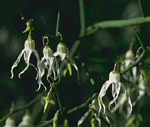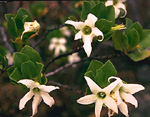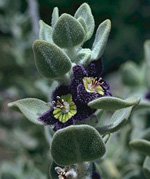 |
This is a large, almost cosmopolitan family, most diverse in warm, dry
regions of the world. In Australia, some members may be found almost anywhere
except in shaded rainforests, in the alps and in saline habitats. The
largest genus, Solanum, is most diverse in arid and semi-arid areas;
many genera are restricted to south-western Western Australia.
Characteristic features of the family Solanaceae in Australia include:
- shrubs or herbs, rarely climbers or small, soft-wooded trees, sometimes
beset with straight spines or thorns, often stellate-hairy
- leaves alternate, simple (sometimes deeply lobed), occasionally reduced
to scales
- flowers regular, usually borne in panicles or umbels, sometimes showy, usually white, blue or purple
- sepals 5, petals 5 and fused into a tubular, salver-shaped or wheel-shaped
(rotate) corolla
- ovary superior, often with a nectary-disc at its base, developing
into berries or capsules
Description
Evergreen trees, or shrubs, or woody or herbaceous vines climbing
by hooks, twining petioles or scrambling, or annual or perennial terrestrial
herbs. Perennating by rhizomes or taproots. Vegetative reproduction absent,
or by rhizomes. Leaves sometimes ±absent. Stems unarmed, or with
prickles or spines arising from the stem surface, or with thorns or spines
arising from the leaf axils. Internal secretions not obvious. Plants glabrous,
or with simple, dendritic or stellate, glandular or non-glandular, unicellular,
uniseriate or multiseriate hairs. Leaves well developed or much reduced
(i.e. to scales, etc), alternate and spiral, cauline or both basal and
cauline if herbs, petiolate or subsessile. Stipules and stipellae absent.
Lamina simple, once compound or bicompound, unifoliolate, ?bifoliolate,
ternate or imparipinnate, symmetric or conspicuously asymmetric, pinnatifid,
pinnatisect, bipinnatifid, tripinnatifid, etc; lamina/lobes filiform,
acicular, subulate, linear, lanceolate, ovate, elliptic, oblanceolate,
oblong or orbicular; base cuneate, attenuate, rounded, oblique or rarely
cordate; margins entire, dentate, serrate, sinuate or spiny, ±flat;
venation pinnate, with the midrib conspicuous, and the tertiary venation
reticulate or not; surfaces not punctate; herbaceous or succulent, rarely
leathery; distinctive odour absent or foetid. Domatia absent, or consisting
of hair tufts in the vein angles. Mostly with all the flowers bisexual,
or rarely with bisexual and male flowers occurring on the same plant,
or with male and female flowers occurring on separate plants. Inflorescences
terminal, axillary, leaf opposed or intercalary, consisting of panicles,
monochasial (raceme-like) cymes or solitary flowers. Bracts and bracteoles
absent. Pollination by insects. Flowers odourless or fragrant, stalked.
Floral disc present or absent; nectaries absent, or present on the disc
or the carpels. Perianth of 2 dissimilar whorls. Calyx regular; segments
fused, with 5 lobes, valvate or open in bud; calyx cup-shaped, bell-shaped,
urn-shaped or tubular, herbaceous. Corolla regular or irregular; segments
fused, with (4–) 5 lobes, alternating with the calyx lobes, valvate in
bud; corolla wheel-shaped, bell-shaped, urn-shaped, funnel-shaped or tubular,
1-lipped, white, cream, yellow, orange, red, pink, magenta, purple, violet,
blue or green, without contrasting markings, or streaked, spotted, etc,
membranous; claws absent; lobes ±entire or notched, emarginate,
bifid or bilobed. Fertile stamens 5, opposite to the calyx lobes, at least
partly fused to the corolla, free of the ovary and style, distinct from
each other or fused by their filaments into an open or closed tube, all
±equal or in 2 unequal pairs. Anthers dorsifixed or basifixed,
versatile or not versatile, opening inwards or terminally by pores, by
short slits or by longitudinal slits, 2-celled; appendages absent or apical.
Ovary superior and sessile. Carpels 1–2, fused; ovary with 2 (–5) locules.
Style terminal, single and unbranched, or single and branched above. Ovules
2–numerous per locule, stalked; placentation axile. Fruit a dry dehiscent
capsule with irregular, septicidal, loculicidal or rarely with circumscissile
dehiscence, or a fleshy indehiscent berry; the perianth on the maturing
fruit deciduous, dry and persistent or growing larger. Disseminule macro-surface
featureless, or with straight hairs; micro-surface ±smooth or reticulate,
cream, yellow, orange, red, violet, green, brown, grey or black, without
contrasting markings, or conspicuously patterned, glossy or dull. Seeds
2–numerous per fruit. Aril present or absent. Cotyledons 2. Embryo straight,
curved or coiled.
(Note: this description has been generated from the coded data compiled for the key. Any errors in the key data will be reflected in the descriptions.)
A treatment of the family Solanaceae has been published in:
Flora of Australia 29: 11-96.
Australian genera of Solanaceae (as recognised for the Flora of Australia)
† = some species native, others introduced
* = all species introduced
Anthocercis
Anthotroche
Browallia
*Capsicum
*Cestrum
Crenidium
Cyphanthera
Cyphomandra
†Datura
Duboisia
Grammosolen
*Hyoscyamus
†Lycium
*Lycopersicon
*Nicandra
†Nicotiana
*Nierembergia
*Petunia
†Physalis
*Salpichroa
†Solanum
Symonanthus
*Withania

|
  |

Anthocercis genistoides (flowers)
Photo: M.Fagg © ANBG

Anthocercis viscosa (flowers)
Photo: A.S.George © A.S.George

Anthotroche pannosa (flowers)
Photo: R.Hotchkiss © ANBG

Cyphanthera anthocercidea (flowers)
Photo: D.Greig © ANBG

|
 |
|